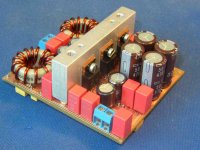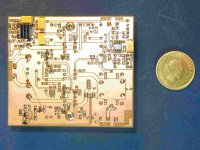After reading a bunch of interesting discussions in this forum I thougt I might share some of my own experiences concerning class D amps.
I've build a class D amp based on the Zetex ZXCD1000 controller.
Output stage incorporates both n-ch and p-ch FET's (IRF540 + IRF5210) in a full bridge topology with capacitivly coupled gate drive. No NFB.
Efficiency is approx. 91% @ 140W/4 ohm (45V supply voltage, 2Vpp, 1kHz sinewave input).
I have not meassured THD performance yet but at first glance it works pretty well. I think the prototype will do as a reasonable counterpoise for further improvements (I'm currently working on a up-grade aiming for 500W/4ohm).
Attached is a picture of the prototype board.
Regards,
Soeren
I've build a class D amp based on the Zetex ZXCD1000 controller.
Output stage incorporates both n-ch and p-ch FET's (IRF540 + IRF5210) in a full bridge topology with capacitivly coupled gate drive. No NFB.
Efficiency is approx. 91% @ 140W/4 ohm (45V supply voltage, 2Vpp, 1kHz sinewave input).
I have not meassured THD performance yet but at first glance it works pretty well. I think the prototype will do as a reasonable counterpoise for further improvements (I'm currently working on a up-grade aiming for 500W/4ohm).
Attached is a picture of the prototype board.
Regards,
Soeren
Attachments
Hi, A few questions
How does it sound ?
Are you sticking with P & N channel fets for the 500w version ?
Regards,
Mark
How does it sound ?
Are you sticking with P & N channel fets for the 500w version ?
Regards,
Mark
Here is a picture of the bottom side of the PCB. As one might see a few modifications were necessary in order to get things to work propperly.
Board dimensions are: 70mm x 80mm (height 30 mm)
Anybody else who has experiences with the ZXCD1000 controller?
The fact that the Zetex controller provides an integrated solution (internal triangle generator and pwm comparator) solves a lot of PCB layout issues otherwise encountered with a more "discrete" design. Well, at least that is my experience after have tried a few other approaches with disappointing results! An other point of interest is the use of a solid ground plane (70u) and seperation of power ground and signal ground (must be connected at one point only!). And of course, propper decoupling not to forget 🙂
Regards,
Soeren
Board dimensions are: 70mm x 80mm (height 30 mm)
Anybody else who has experiences with the ZXCD1000 controller?
The fact that the Zetex controller provides an integrated solution (internal triangle generator and pwm comparator) solves a lot of PCB layout issues otherwise encountered with a more "discrete" design. Well, at least that is my experience after have tried a few other approaches with disappointing results! An other point of interest is the use of a solid ground plane (70u) and seperation of power ground and signal ground (must be connected at one point only!). And of course, propper decoupling not to forget 🙂
Regards,
Soeren
Attachments
Regarding the sound quallity of the amplifier....well I have only build one prototype and tested it on a loudspeaker in a laboratory environment! I don't think it would be fair to make a final conclusion based on those harsh conditions but on the face of it the sound quality seems reasonable. I might mention that this amp is intended for a subwoofer.
Regards,
Soeren
Regards,
Soeren
I forgot to answer the second question - sorry Mark.
I'll try to go as far as possible with the present design - or at least as far as the 100V FET's will get me. However, I have a hunch that tells me that the P-channel FET's will give me some trouble so I might go for a pure N-channel solution using a couple of LM51xx high side drivers.
Regards,
Soeren
I'll try to go as far as possible with the present design - or at least as far as the 100V FET's will get me. However, I have a hunch that tells me that the P-channel FET's will give me some trouble so I might go for a pure N-channel solution using a couple of LM51xx high side drivers.
Regards,
Soeren
thecyberdude said:Anybody else who has experiences with the ZXCD1000 controller?
Some - but at lower powers ~ 50W, if I can help just ask away....
John
- Status
- Not open for further replies.
- Home
- Amplifiers
- Class D
- My Class D SMPA project

